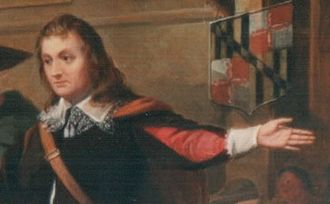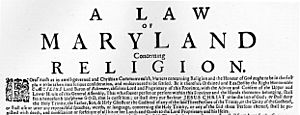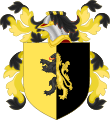William Stone (Maryland governor) facts for kids
Quick facts for kids
William Stone
|
|
|---|---|

William Stone, 3rd Proprietary Governor of Province of Maryland
|
|
| 3rd Proprietary-Governor of Province of Maryland | |
| In office 1649–1656 |
|
| Preceded by | Thomas Greene |
| Succeeded by | Josias Fendall |
| Personal details | |
| Born |
William Maximillian Stone
c. 1603 Northamptonshire, England |
| Died | c. 1660 Charles County, Maryland |
| Spouse | Verlinda Stone |
| Profession | Businessman, planter, land owner, colonial government official, colonial governor |
| Signature | |

William Stone (around 1603 – around 1660) was an early English settler in Maryland. He became the 3rd Proprietary Governor of the Province of Maryland. He served as governor from 1649 to 1655.
Contents
William Stone's Early Life and Arrival in America
William Stone was born in Northamptonshire, England, around the year 1603.
In 1619, when he was about 16 years old, William Stone sailed to America. He arrived in the Virginia Colony on a ship called the Margaret of Bristol. He was part of a group of new colonists sent to work at a place called Berkeley Hundred.
Early Business and Land Ownership
William Stone worked for six years for the investors of Berkeley Hundred. In return, he was promised 30 acres of land. By 1635, he had gained ownership of a large area of land, about 1,800 acres, in a place called Accomack.
Family Life and Government Role
William Stone had two brothers, Andrew Stone and Captain John Stone. They were involved in trading on the Eastern Shore of Virginia.
Around 1636, William Stone married Verlinda Graves. She was the daughter of Captain Thomas Graves. William Stone became an important person in the local government. He served as a commissioner for the county court. He also became a sheriff and a vestryman, which was a church official. By 1645, he was living in Northampton County.
Puritan Settlers in Maryland
William Stone came to America with a group of Puritans. Puritans were a group of Christians who wanted to "purify" the Church of England. They first settled in Virginia.
However, the Puritans in Virginia often disagreed with the official Church of England. In 1648, William Stone made an agreement with Cecilius Calvert, who was the leader of Maryland. This agreement allowed the Puritan colonists from Virginia to move and settle in the central part of the Province of Maryland.
William Stone as Governor of Maryland
On August 8, 1648, Lord Baltimore chose William Stone to be the Governor of Maryland. He was the first Protestant governor of the colony.
The Maryland Toleration Act
The people in Maryland wanted to make sure everyone had religious freedom. In 1649, Governor Stone signed an important law called the Maryland Toleration Act. This law allowed all Christian groups to practice their religion freely in Maryland.
In the same year, William Stone and the Puritan settlers from Virginia founded a new town. They named it Providence. This town is now known as Annapolis, Maryland, which is the capital of Maryland today.
Conflict and Defeat
In 1654, there was a big conflict in England called the English Civil War. After this war, forces loyal to the Parliament took control of Maryland. Governor Stone had to leave and went to Virginia.
However, Lord Baltimore ordered Stone to return. The next spring, Stone came back with his own group of soldiers. But on March 25, 1655, in a fight known as the Battle of the Severn, Stone was defeated. He was captured and taken prisoner. After this, William Stone was replaced as governor by Josias Fendall. He did not take part in public affairs anymore.
Later Years and Legacy
William Stone wrote his will in December 1659. He passed away around 1660 in Charles County, Maryland. His wife, Verlinda Graves Stone, wrote her will in 1674 and passed away in 1675.
Land Grant and Family Legacy
In 1660, the king was restored to power in England, and Lord Baltimore's government was restored in Maryland. As a reward for William Stone's loyalty, Lord Baltimore gave him a large piece of land. Stone focused on developing his plantation, called Poynton Manor, in Charles County.
William Stone's family continued to be important in Maryland. His great-grandson, David Stone, made the family's estate much more valuable. Several of William Stone's great-great-grandsons made big contributions to Maryland's history:
- Thomas Stone signed the Declaration of Independence.
- Michael Jenifer Stone represented Maryland in the first United States Congress.
- John Hoskins Stone was the Governor of Maryland from 1794 to 1797.
- William Murray Stone became an Episcopal Bishop in Baltimore.
Another descendant, Barton W. Stone, was an important leader in a religious movement called the Restoration Movement.
Images for kids



